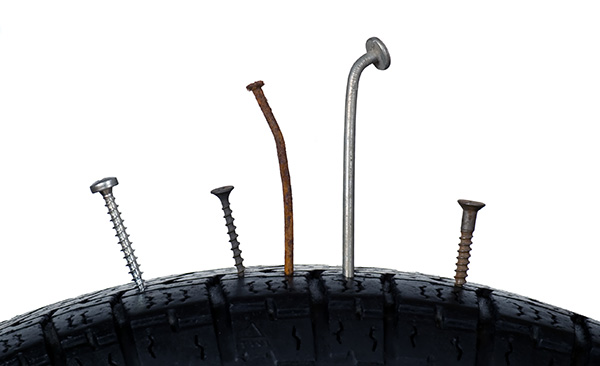
Tire punctures are an unfortunate and often unavoidable part of driving. But the big question is, can all tire punctures be repaired? Understanding when a puncture is repairable and when it's time to replace the tire can save you time, money, and potential safety risks. Let's look into the details and demystify the world of tire repairs.
1. Types of Tire Punctures
Not all tire punctures are created equal. The type of puncture plays a significant role in whether or not it can be repaired.
Small Punctures
Small punctures, usually caused by nails or screws, are the most common type. These punctures typically occur in the tread area and are generally easy to repair. A tire professional can often fix these with a simple plug or patch, getting you back on the road quickly.
Sidewall Damage
Damage to the sidewall is a different story. The sidewall of a tire is crucial for maintaining structural integrity. Punctures or cuts in this area are not repairable because they compromise the tire's strength and could lead to a blowout. In such cases, tire replacement is the only safe option.
Large Punctures and Cuts
Large punctures or cuts, regardless of their location, often render a tire irreparable. If the hole is bigger than a quarter inch, or if the tire has sustained multiple punctures close together, it's typically recommended to replace the tire.
2. Factors Affecting Tire Repair
Several factors determine whether a puncture can be repaired. Understanding these can help you make an informed decision.
Location of the Puncture
The location of the puncture is crucial. Punctures in the tread area are often repairable, while those in the shoulder or sidewall are not. The tread area is the thickest part of the tire and is designed to withstand punctures better.
Size of the Puncture
The size of the puncture also matters. Small punctures, usually less than a quarter inch in diameter, are repairable. Larger punctures compromise the tire's structural integrity and are typically not fixable.
Number of Punctures
If a tire has multiple punctures, especially if they are close to each other, it may not be safe to repair. Too many repairs can weaken the tire, making it unsafe to drive on.
3. The Repair Process
So, how exactly is a tire repaired? The process is quite straightforward but requires professional expertise to ensure safety and durability.
Inspection
The first step is a thorough inspection. A tire professional will remove the tire from the wheel and examine it inside and out. They look for punctures, tears, and any signs of internal damage.
Preparation
If the puncture is deemed repairable, the area around the puncture is cleaned and prepped. This ensures that the patch or plug adheres properly and the repair is durable.
Repair
There are two common repair methods: plugging and patching. Plugs are used for small punctures and are inserted from the outside. Patches are applied from the inside and are typically more secure. In some cases, a combination of both is used for added strength.
Reinstallation and Testing
After the repair, the tire is reinstalled on the wheel and tested for leaks. This ensures that the repair is secure and the tire is safe to use.
4. When to Replace a Tire
There are certain situations where replacing the tire is the only safe option.
Extensive Damage
If the tire has extensive damage, such as large cuts or sidewall punctures, it must be replaced. Driving on a compromised tire is extremely dangerous and not worth the risk.
Worn Tread
If the tread on your tire is worn down, it's a sign that the tire needs to be replaced. Even if a puncture is repairable, a tire with insufficient tread won't provide adequate traction and safety.
Multiple Repairs
A tire that has been repaired multiple times may no longer be safe. Too many repairs can weaken the tire, making it more prone to failure.
5. Preventing Tire Punctures
While not all punctures can be prevented, there are steps you can take to reduce the risk.
Regular Inspections
Regularly inspecting your tires for signs of wear and tear can help you catch potential issues before they become major problems. Look for embedded objects, cracks, and uneven wear patterns.
Proper Inflation
Keeping your tires properly inflated is crucial. Underinflated or overinflated tires are more susceptible to damage. Check your tire pressure regularly and adjust as needed.
Safe Driving Habits
Avoiding road hazards, such as potholes and debris, can help prevent punctures. Driving carefully and maintaining a safe distance from construction zones can also reduce the risk.
Keep your tires in top condition with regular inspections and maintenance at Neighborhood Tire Pros. Schedule your appointment today!